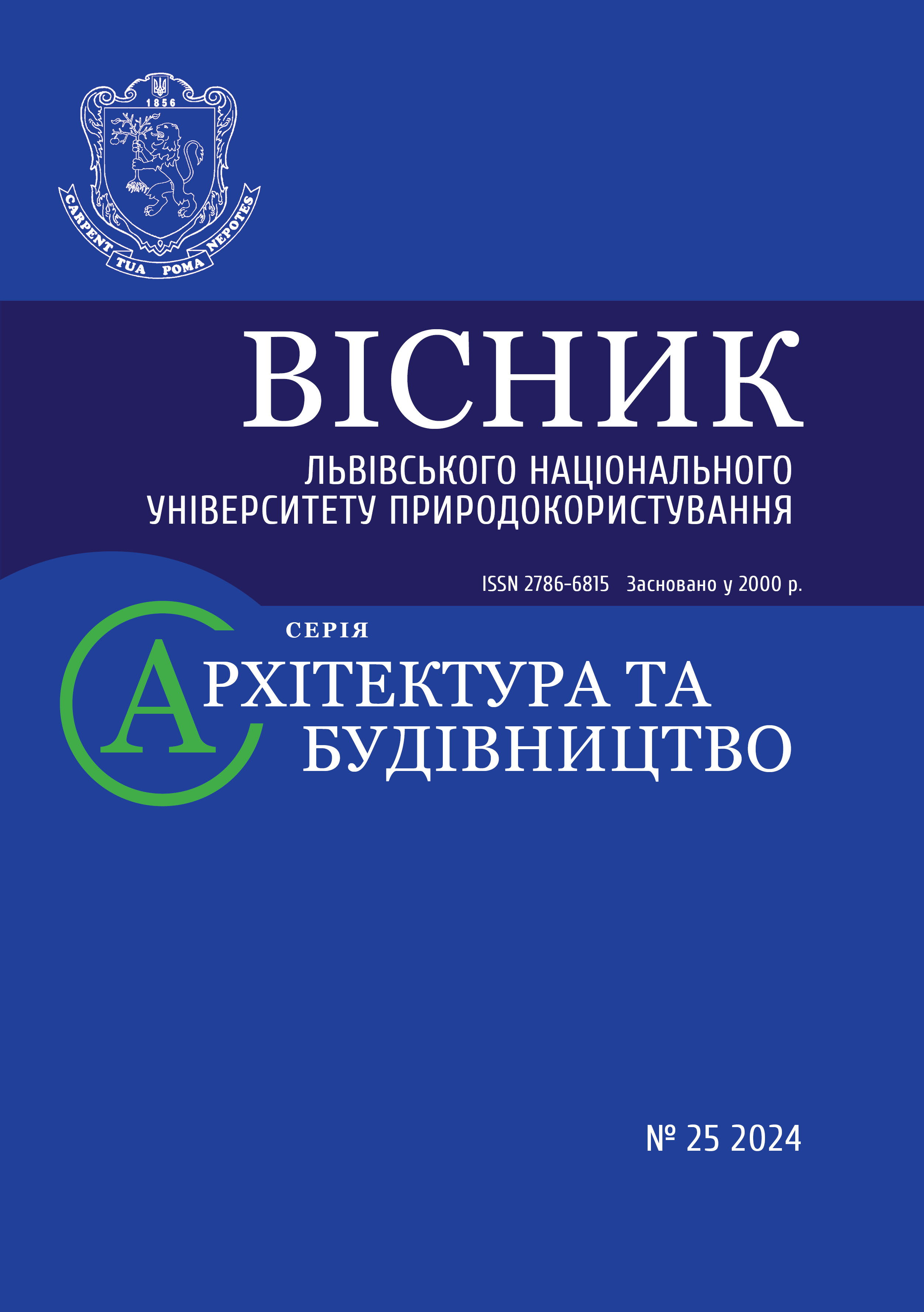БАГАТОЦІЛЬОВА КОНСОЛІДАЦІЯ ЗЕМЕЛЬ ДЛЯ СТАЛОГО РОЗВИТКУ ТЕРИТОРІАЛЬНИХ ГРОМАД УКРАЇНИ
DOI:
https://doi.org/10.31734/architecture2024.25.169Ключові слова:
багатоцільова консолідація земель, просторова реструктуризація землекористування, перерозподіл прав власності, цілі сталого розвиткуАнотація
У країнах Західної Європи сучасна консолідація земель є багатоцільовим інструментом управління земельним ресурсами та планування простору з метою розвитку сільського господарства, будівництва масштабної інфраструктури, відновлення природних ландшафтів, збереження біорізноманіття, адаптації до зміни клімату та пом’якшення її наслідків тощо. Проведено контент-аналіз текстової інформації про багатоцільовий підхід до консолідації земель як інструмента землеустрою, спрямованого на зміну структури власності через перерозподіл земельних ділянок для просторової реструктуризації землекористування сільської місцевості для сталого розвитку територіальних громад України. Під просторовою реструктуризацією землекористування автори розуміють інтегрований підхід до реорганізації сільських територій з метою кількісних і якісних змін, де кількісний аспект проявляється у зміні землекористування, а якісний - у зміні екосистемних активів громади. Описано взаємозв’язок між сталим розвитком територіальних громад і просторовою реструктуризацією землекористування через консолідацію земель. Акцентовано на ключових елементах процедури багатоцільової консолідації земель. Проаналізовано деякі просторові проблеми землекористування сільських територій в Україні, які доцільно вирішувати за допомогою консолідації земель як інструмента землеустрою. Зокрема наголошено на збереженні та відновленні екосистемних активів громади через вилучення ерозійно небезпечних масивів під консервацію-трансформацію, формування екологічних мереж для створення цілісної природоохоронної інфраструктури, відновлення і об’єднання масивів лісових угідь. Запропоновано розробити Національну програму консолідації земель, яка б створила умови для включення консолідації земель у загальну земельну політику держави та розроблення фінансової, технічної й адміністративної підтримки впровадження проєктів консолідації земель на місцях.
Посилання
Asiama K. O., Bennett R. M., Zevenbergen J. A. Land Consolidation on Ghana's Rural Customary Lands: Drawing from The Dutch, Lithuanian and Rwandan Experiences. Journal of Rural Studies. 2017. Vol. 56. P. 8799.
Blishchuk K. Sustainable development of territorial communities in the context of decentralization changes. Economic space. 2024. No 190. P. 104–107. DOI: https://doi.org/10.32782/2224-6282/190-19.
Development of complex plans: A guide for communities. Kyiv, 2022. 88 p.
Dudzińska M., Kocur-Bera K. Land consolidation as the driving force behind ecological and economic development of rural areas. Environmental Engineering. Proceedings of the International Conference on Environmental Engineering. 2014. Vol. 9. P. 1–7.
Emerald Network General Viewer. URL: https://emerald.eea.europa.eu/ (Accessed June 19, 2024).
FAO kicks off project aimed at tackling land degradation in Ukraine. URL: https://www.fao.org/europe/news/detail/-FAO-kicks-off-project-aimed-at-tackling-land-degradation-in-Ukraine/en (Accessed June 25, 2024).
GISFile Available. URL: https://gisfile.com/map/ (Accessed June 19, 2024).
Google Earth. URL: https://earth.google.com/web/ (Accessed June 19, 2024).
Hartvigsen M. Experiences with land consolidation and land banking in Central and Eastern Europe after 1989. FAO, 2015. 138 p.
Hartvigsen M. The potential of multi-purpose land consolidation in Eastern Europe. FAO, 2022. 21 р.
Land bank. URL: https://landbank.spfu.gov.ua/ (Accessed June 21, 2024).
Louwsma M., de Vries W., Hartvigsen M. Land Consolidation – the Fundamentals to Guide Practice. FIG report. Denmark, 2022. 78 p.
Mainstreaming the national land consolidation programme in north Macedonia. FAO, 2023. 2 p.
Pereira P., Inacio P., Kalinauskas M., Bogdzevic K., Bogunovic I., Zhao W. Land-use changes and ecosystem services. Mapping and Forecasting Land Use. 2022. P. 1–27.
Popov A. S. Institutional Foundations of Agricultural Land Consolidation: Theory, Methodology, Practice: thesis ... Dr. Economic Sciences: 08.00.06. Lviv, 2018. 472 p.
Popov A., Movchan, Serhii & Kolomiiets, Serhii & Lezhenkin, Ivan. (2020). Formation of agricultural land layout as an alternative of land consolidation. Economic and social geography. 2020. 84. P. 4254.
Shvorak A. M. Consolidation of lands of agricultural purpose: thesis ... Dr. Economic Sciences: 08.00.06. Kyiv, 2016. 438 p.
Summers J., Smith L., Fulford R., Crespo R. The Role of Ecosystem Services in Community Well-Being. 2018. P. 145–168.
The Draft Law on the Consolidation of the Land Market – fifteen main provisions of the document. 2024. URL: https://agropolit.com/spetsproekty/1033-zakonoproekt-pro-konsolidatsiyu-rinku-zemli--pyatnadtsyat-osnovnih-polojen-dokumentu (Accessed May 24, 2024).
Tkachuk L. V. Consolidation of lands: effective use and protection in conditions of transformation of land relations: monograph. Lviv: Lviv National Agrarian University, 2009. 249 p.
Tomas Y. Land management and land consolidation in rural areas of Germany. Kyiv; Nizhyn: Publisher Lysenko M. M., 2021. 428 p.
Tymchenko I. V., Krysinska D. O., Hulevets V. V., Ivanov D. A., Savchenko S. A. Environmental consequences of war for communities: results of a pilot assessment and recommendations. Kyiv, 2024. 72 p.
Veršinska T., Vidar M., Hartvigsen M., Mitic Arsova K., van Holst F., Gorgan M. Legal guide on land consolidation: Based on regulatory practices in Europe. FAO Legal Guide, No 3. Rome, 2020. 192 p.
Voluntary national review of the Sustainable Development Goals in Ukraine. 2020. 117 p.
Wolf M. J., Emerson J. W., Esty D. C., de Sherbinin A., Wendling Z. A., et al. 2022 Environmental Performance Index. New Haven, CT: Yale Center for Environmental Law & Policy, 2022. 104 p.


